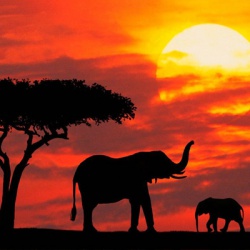
Kenya’s natural vegetation

Kenya’s natural vegetation is as diverse as its climate and topography would suggest. Dean & Trump (1983) mapped 19 distinct biotic communities; some of which can be lumped under general headings.
Afro-alpine moorland (1.2 % of total land area) occurs above c. 3,000 m, on Mt Kenya and Mt Elgon, the Cheranganis and the Aberdare Mountains.
The vegetation is sparse at the upper levels (above c.3, 800 m), with species of giant Lobelia and Senecio; below this is grassland and Erica shrubland, often with stands of Hagenia abyssinica in sheltered spots.
Highland grassland (0.05%) occurs above c.2,400 m on either side of the central Rift Valley (in the Kinangop and Mau Narok / Molo Grasslands. This restricted habitat is not covered in any protected area and is one of the most endangered in Kenya.
Many tussock-forming grass species occur. Other important grassland types include fire-induced grassland (3.1 %, e.g. parts of the masai Mara) and seasonal floodplain and delta grassland (4.7%, e.g. the Tana river Delta).
Grassland also occurs on alkaline volcanic ash (0.2%), e.g. to the south of the Chyulu Hills.
Highland moist forest (2.0%) occur between c.1, 500 m and 3,000m in areas that receive rainfall of more than 1,200 mm per year. A mosaic of forest and bamboo Arundinaria alpina is often present at the higher levels.
Typical montane forest trees include species of Podocarpus, Olea, Juniperus and Newtonia, but the forest type varies greatly according to altitude and rainfall.
Relicts of Guineo-Congolian rainforest (0.1%) occur in western Kenya, in and around Kakamega Forest.
Despite its relatively high altitude (1,600m), in terms of biogeography Kakamega is the easternmost outlier of the great tract of tropical rain forest that once extended across equatorial Africa.
The average annual rainfall is over 1,900 mm, and typical tree species include Celtis, Aningeria, croton, Fagara and Manikara. The North and South Nandi Forests are transitional between the Guinea-Congolian and Montane forest forest types.
Several types of coastal forests and woodland (0.1%) characteristic of the Zanzibar-Inhambane Mosaic vegetation region, occur along the narrow coastal strip.
These patches are mainly small and relictual, and the forest structure and composition vary greatly according to soil type and rainfall. Characteristic trees include Cynometra, manikara, Afzelia, Brachylaena and Brachystegia.
Coastal evergreen bushland (0.4%) also occurs, in a mosaic with cultivated land; this is almost always a secondary vegetation type. Coastal palmstands, often in tall grassland, are a rare vegetation type covering ess than 3.1% of the land area.
They are concentrated near the Ramisi River in the south, and around the Tana River Delta in the north. Elsewhere, highland dry forests (0.4%) occur on hilltops that attract mist and rain (e.g. Mt Marsabit and the Taita and Chyulu Hills. Riverine forests (e.g. along the Mara River) and groundwater forests (e.g. Kitovu) together make up c.1.5% of the land area.
Thorn bushland and woodland are the most extensive vegetation types in Kenya (41.7%), running from Amboseli in the south through the Tsavo parks to north-east and north-west Kenya.
Characteristic tree species are Acacia, Commiphora ssp., while grasses include species of Hyparrhenia, Digitaria and Themeda.
This habitat often contains concentrations of large mammals and many large protected areas are in this vegetation zone. It is often favourable for ranching and pastoral land. This vegetation grades into semi-arid wooded and bushed grassland (0.2%).
The north-central and northwestern parts of the country are covered by semi-desert (16.8%) with characteristic shrubby thornbush species, mainly Acacia.
In places, such as the Dida Galgalu and Chalbi deserts and around Lake Turkana, areas of barren land (0.4%) occur, with very little vegetation. Marine beaches and dunes make up another 0.04% of the land area.
Wetlands are an important habitat in Kenya, covering about 14,000 km sq of the country’s land surface (Crafter et al. 1992).
Strongly alkaline Lakes (0.04%), mainly in the Rift valley, lack macrophytes, except at river inflows, but may have large blooms of microscopic plants - notably the cynaophytes Spirulina spp.
Papyrus swamps, consisting largely of stands of cyperus papyrus, are found patchily around the shores of Lake Victoria, mainly along river inflows.
Elsewhere this habitat is widely scattered, with notable patches at Lake Naivasha and Lake Jipe. (Only Lake Victoria’s papyrus holds the suite of bird species specialized on this habitat) Swamps of other Cyperus species, Typha and Phragmites occur locally but are rarely of any great size.
Permanent swamps make up 0.11% of the land area, while bodies of freshwater cover 2.1% fo Kenya’s surface area.
Mangrove swamps (0.2%) occur along parts of the Kenyan shoreline, especially in sheltered creeks and estuaries. Eight species of mangrove occur, the commonest of which is Rhizophora mucronata. Lamu district has the country’s most extensive mangrove swamps.
On sandy shorelines are often beds of seagrass (some twelve species are recorded), beyond the littoral zone or in deeper channels within it.
Coral reefs and islands make up some 59,000 ha, or 0.1% of the land area. Human-modified habitats, created at the expense of the natural vegetation, occur throughout the country but especially in the highlands.
These include cultivated land under a wide variety of crops (18%), plantations of exotic trees, secondary thicket and scrub, eroded and de-vegetated woodland and bushland, and overgrazed pastureland.
Services
Kenya Wildlife ServiceThe international launch of the East African Single Joint Visa at the ITB Berlin ...
The Embassy of Kenya - Ankara, Turkeyhttps://www.kenyaembassy.org.tr/# Address: İlkbahar, Yildiz, Ilkbahar Mah. Galip Erdem Cad, 613. Sk. No. ...
Safari in KenyaKenya offers a variety of tourist attractions which range from wildlife safaris, beach holidays, ornithology, camping and hiking to conference tourism ...
MAIN CONTACTS
Visas can be obtained at the Kenya Embassy in Berlin.
CONTACT CONSULATE IN SOFIA:
3, Pozitano Street, 2nd floor, 1000 Sofia, Bulgaria
tel./fax: (+3592) 986 58 96; 988 26 52
e-mail: consulate@kenya-bulgaria.org
Facebook: https://www.facebook.com/consulatekenya.bulgaria
Working Hours:
10:30 – 12:30